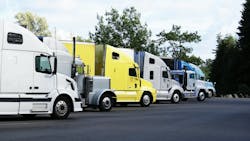Fontana: Now is a good time to improve asset utilization
No one likes uncertainty, yet it seems we are in that period due to the ongoing issue with tariffs. Uncertainty can make it more challenging to make decisions, yet we all have to continue to run our businesses.
As we wait for clarity, we can spend some time looking inward to try to ferret out operational inefficiencies. One key area where you may be able to find some efficiency is in asset utilization.
Asset utilization measures how efficiently your organization uses its assets. Basically, it measures the amount of time your equipment is in use compared to the amount of time it could be used. Understanding your trailer turns and maximizing efficiency may be a utilization analysis in itself, depending on the type of operation, loading, and staging processes.
Utilization can be measured on a daily, weekly, or monthly basis. Choose a time span that makes sense for you. You need a baseline as a starting point to gauge improvement as you make changes to your operation. Determine the number of hours an asset is in use during the period of time you are examining.
To quantify the utilization percentage for the entire fleet, you need to know the total number of vehicles in your fleet, the maximum number of hours those trucks can operate, and the number of hours they actually operate.
From there, it is a simple math calculation where you take the number of hours the vehicle is in use divided by the total number of hours available and then multiply that by 100 to get the percent of fleet utilization.
See also: Big 3: Resilience, innovation, trump uncertainty
Other things to explore include the amount of product the asset can carry—does the load cube out before it weights out—driver’s available hours of service, and the requirements of your customers. Also, look at how often the truck goes out less than full, the number and duration of stops, and the time of day the truck must be on the road in order to meet the delivery requirements of the customer.
Another key consideration for utilization is peak period and surges. Fleets may have enough equipment to handle the steady state but not to cover the surge, while others may be able to handle volume surge which avoids rental costs but leaves them equipment heavy during non-surge times. This may not be a problem, but is something fleets need to be aware of.
To be clear, it is not likely you will ever get to 100% utilization. There are just too many variables, including hours of service, weather, traffic, and delays at shipper or at customer locations.
Once you have determined the utilization percentage of each asset, you can start looking for ways to improve it. One thing you can do is look at your routing. Can you adjust your routing to get better utilization out of an asset? Check with your customers to see if there have been any changes to their delivery needs. Can you alter delivery times for them while still satisfying their needs and improving your asset utilization rate? You don’t want to compromise customer service by changing delivery windows, but there is no harm in opening a discussion with customers about it.
If you improve your fleet utilization during this period of uncertainty, you will be well-positioned to remain profitable when the situation becomes clearer.
About the Author
Gino Fontana
Chief operating officer and executive vice president at Transervice Logistics Inc.
Gino Fontana, CTP, is COO and EVP at Transervice Logistics Inc. His operational expertise emphasizes cost savings, process efficiency and improvement, superior quality, and people management skills. He has more than 35 years of experience in the transportation and logistics industry with both operational and sales experience.
